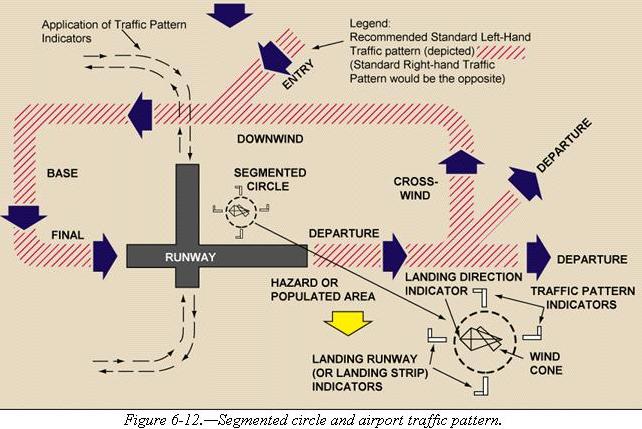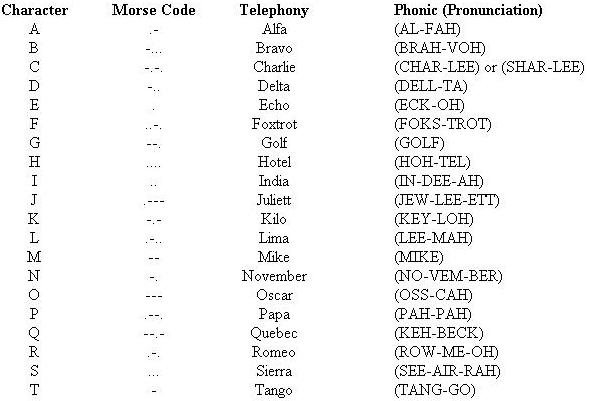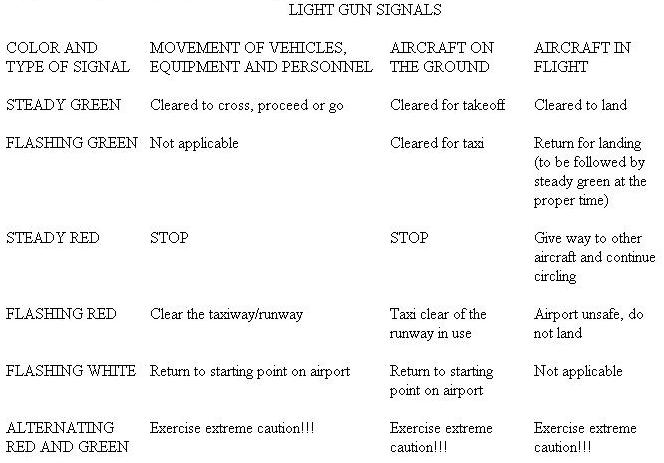6-5
WIND DIRECTION INDICATORS
It is important for a pilot to know the direction of the wind.
At facilities with an operating control tower, this information is provided
by ATC. Information may also be provided by FSS personnel located at a
particular airport or by requesting information on a common air traffic
frequency (CTAF) at airports which have the capacity to receive and broadcast
on this frequency.
When none of these services are available, it is possible to
determine wind direction and runway in use by visual wind indicators. A
pilot should check these wind indicators even when information is provided
on the CTAF at a given airport because there is no assurance that the information
provided is accurate.
| Wind direction indicators include a wind sock, wind tee,
or tetrahedron. These are usually located in a central location near the
runway and may be placed in the center of a segmented circle which will
identify the traffic pattern direction if it is other than the standard
left-hand pattern. [Figures 6-11 and 6-12]
The wind sock is a good source of information since it not only indicates
wind direction, but allows the pilot to estimate the wind velocity and
gust. The wind sock extends out straighter in strong winds and will tend
to move back and forth when the wind is |
|
gusty. Wind tees and tetrahedrons can swing freely, and will align themselves
with the wind direction. The wind tee and tetrahedron can also be manually
set to align with the runway in use, therefore a pilot should also look
at the wind sock if available.
 |
RADIO COMMUNICATIONS
Operating in and out of a controlled airport, as well as in a good portion
of the airspace system, requires that an aircraft have two-way radio communication
capability. For this reason, a pilot should be knowledgeable of radio station
license requirements and radio communications equipment and procedures.
Radio License
There is no license requirement for a pilot operating in the United |
States; however, a pilot who operates internationally is required to hold
a restricted radiotelephone permit issued by the Federal Communications
Commission (FCC). There is also no station license requirement for most
general aviation aircraft operating in the United States. A station license
is required however for an aircraft which is operating internationally,
which uses other than a very high frequency (VHF) radio, and which meets
other criteria.
| Figure 6-13.—Phonetic alphabet. |
 |
 |
Radio Equipment
In general aviation, the most common types of radios are VHF.
A VHF radio operates on frequencies between 118.0 and 136.975 and is classified
as 720 or 760 depending on the number of channels it can accommodate. The
720 and 760 uses .025 spacing (118.025, 118.050, etc.) with the 720 having
a frequency range up to 135.975 and the 760 going up to 136.975. VHF radios
are limited to line of sight transmissions; therefore, aircraft at higher
altitudes are able to transmit and receive at greater distances.
Radio Procedures
Using proper radio phraseology and procedures will contribute
to a pilot’s ability to operate safely and efficiently in the airspace
system. A review of the Pilot/Controller Glossary contained in the Aeronautical
Information Manual (AIM) will assist a pilot in the use and understanding
of standard terminology. The AIM also contains many examples of radio communications
which should be helpful.
The International Civil Aviation Organization (ICAO) has adopted
a phonetic alphabet which should be used in radio communications. When
communicating with ATC, pilots should use this alphabet to identify their
aircraft. [Figure 6-13]
Lost Communication Procedures
It is possible that a pilot might experience a malfunction of
the radio. This might cause the transmitter, receiver, or both to become
inoperative. If a receiver becomes inoperative and a pilot needs to land
at a controlled airport, it is advisable to remain outside or above Class
D airspace until the direction and flow of traffic is determined. A pilot
should then advise the tower of the aircraft type, position, altitude,
and intention to land. The pilot should then continue and enter the pattern,
report his or her position as appropriate, and watch for light signals
from the tower. Light signal colors and their meaning are contained in
figure 6-14.
Figure 6-14.—Light gun signals.
If the transmitter becomes inoperative, a pilot should follow the previously
stated procedures and also monitor the appropriate air traffic frequency.
During daylight hours air traffic transmissions may be acknowledged by
rocking the wings, and at night by blinking the landing light.
When both receiver and transmitter are inoperative, the pilot
should remain outside of Class D airspace until the flow of traffic has
been determined and then enter the pattern and watch for light signals.
If a radio malfunctions prior to departure, it is advisable to
have it repaired if possible. If this is not possible, a call should be
made to air traffic and the pilot should request authorization to depart
without two-way radio communications. If authorization is given to depart,
the pilot will be advised to monitor the appropriate frequency and/or watch
for light signals as appropriate.




